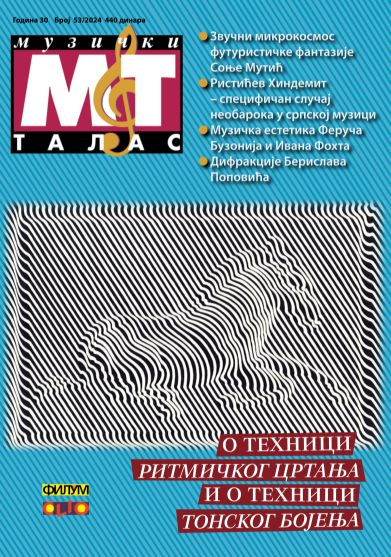О ТЕХНИЦИ РИТМИЧКОГ ЦРТАЊА И О ТЕХНИЦИ ТОНСКОГ БОЈЕЊА
ABOUT THE TECHNIQUE OF RHYTHMIC DRAWING AND THE TECHNIQUE OF TONAL COLORING
Author(s): Dragan LatinčićSubject(s): Music, History of Art
Published by: Izdavačko preduzeće CLIO
Keywords: rhythmic drawing; tonal coloring; Inflections; String quartet; Byzantine; Gostuški; corps sonore
Summary/Abstract: The technique of rhythmic drawing and the technique of tonal coloring bring countless possibilities through the practical-compositional and analytical aspect. In this work, I tried to include only the essential characteristics of the mentioned techniques that describe my style to the greatest extent. I consider the introduction of strict mathematical formulations relevant, although I try not to give the impression of any predictability in the music I compose. Also, in the text I included a description of the origin of the relevant algorithms by means of the projection of har- monics of the spectrum, which, in my opinion, are an inseparable part of deep philosophical reflection, as well as the analytical and compositional-practical experience of two composers and modern Pythagoreans: Dragutin Gostuški and Vlastimir Trajković. Therefore, I owe them the greatest credit for profiling my style, which implies expression, form and language. The primary level of my compositional process, at the moment when I decide on a composition in the style of a rhyth- mic drawing, is precisely the rhythmic structuring based on harmonic spectrum projection methods, and at the center of the event is an interval – an interval as an empty space, an intermediate space or an erased space, i.e. a spatial void (cavity), – therefore, in one extended definition, – an interval as the time distance between two adjacent sound incidents, but a fantastic working surface for research. Here, I would like to point the reader to read about the harmonic spectrum projection method to which I dedicated my entire work On the Path of Hittite Rhythms – Spectrum Projections in Music- Mathematical Analysis, in the journal Muzički Talas number 50, year 2021, p. 40-64). In the text, short sections from the compositions: Inflections for Piano (2019) and String Quartet (2020) were selected, which also served as an example of an analytical overview of the complete tonal system in most of my other compositions. I based the principle of my harmonic language, primarily, on the interpretations of the German musicologist Kurt Sachs related to the writings of Aristoxenus, which refer to tonal colorings within the ancient tonal families. I have been interested in the field of micro-chromatics for many years, and I dedicated a lot of time to it to redefine my language, first of all with the aim of creatively upgrading the tonal system as a whole, but also with the aim of a potential restoration of the Byzantine theory of music, which relies heavily on ancient Greek theory. First of all, I developed my own method of micro-chromatic tonal coloring. By micro-chromatic tonal coloring I mean a given reference system within the octave area that can be evenly distributed, that is, broken down, into various untempered tonal units that form deviations, that is intonational distances. In this paper, I rounded off the story about the interpolation of micro-tones within the octave area and the problems that music theory has faced throughout history with an essay related to the principle of tetrachordal construction attrib- uted to Archita of Taranto, which is directly related to the Byzantine legacy of ancient Greek music theory. Archita’s tet- rachordal tonal systems were performed by means of harmonic means of two pitches. Archita’s principle of tetrachordal construction is also valuable for the reason that the octave does not necessarily have to be taken as the root of the interval division. So, the interval on which we would perform the division could be the choice of a higher harmonic in relation to the fundamental, say duodecima (3:1), quintdecima (4:1) as well as other super-particulate ratios. At different levels of micro-chromatic saturation within the octave area, which would constitute micro-shifts, such as halves, quarters, eights and sixteenths of a whole degree, I managed to define and unify the partial frequencies up to the one hundred and twenty-eight (128) index number of the spectrum, and even over the mentioned number. Also, by divid- ing the octave area into thirds, sixths, and twelfths of a whole degree, I theoretically managed to define the frequencies above the two hundred and fifty-sixth (256) index number of harmonics of the spectrum. Here I would like to mention that writing a sequence also implies its micro-chromatic transpositions, which greatly slows down the preparation for composing. Generating frequencies is a long process because it requires constant mathematical and notational-graphic checks, and notational softwares do not have algorithms that would speed up the transposition process. This is not only about the original form of the harmonic spectrum with its micro-chromatic transpositions, but also about such forms in which the palette of harmonics would be narrowed or stretched. Spectralists use this method. Con- sidering that I spent a long period of time examining the newly obtained relationships at various levels of brevity and stretching of the spectral series, I also saw that is such relationships there is a low identical to that which prevails in the relationships of harmonics in the original form of the spectrum.
Journal: Muzički talas
- Issue Year: 30/2024
- Issue No: 53
- Page Range: 2-23
- Page Count: 22
- Language: Serbian
- Content File-PDF

